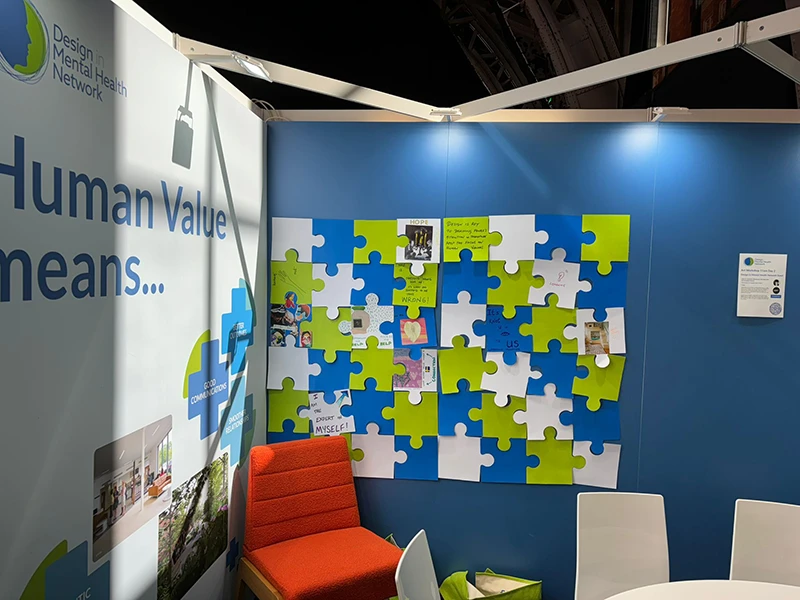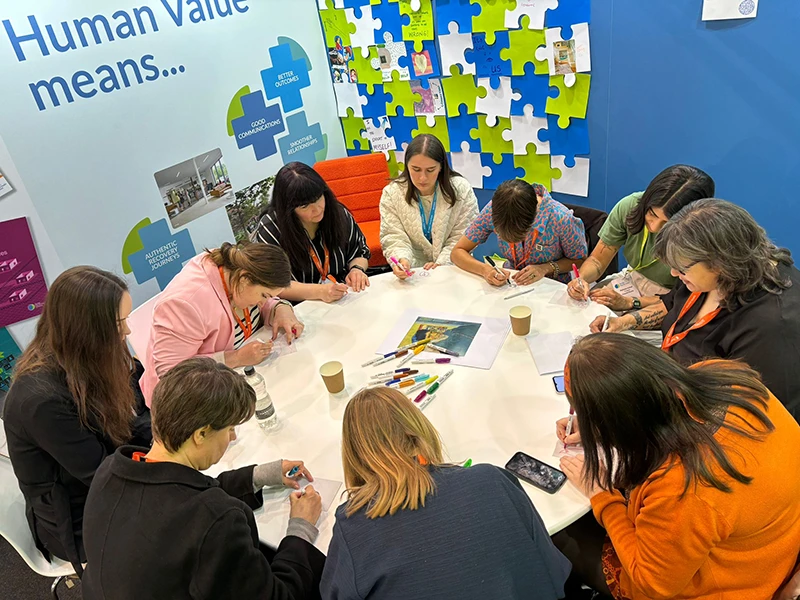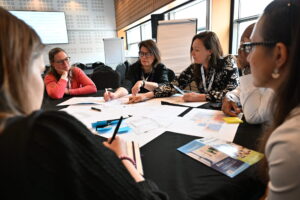Thanks so much to everyone who contributed thoughts and input to the conversations on our stand around the theme of Good Design and Human Value. The proposition prompted much useful discussion focusing on principles of person centred and trauma informed design. Led by members of our Lived Experience Advisory Panel, the lived experience viewpoint that informed these conversations came out loud and clear in the principles that were co created, which looked at the essentials of Good Design and the tenets of Human Value.
We’re keen to keep co-creating these views. We’re aware of the debt they pay to Trauma Informed Design, and we aren’t starting from first principles here, but rather building a joint understanding that can serve our research and investigations as we go further down the route of assessing and validating the claim that Good Design leads to the realisation of Human Value.
The feedback was taken in multiple ways, on a mentimeter, in conversations that were later noted down, in the guest book, and most prolifically, in jigsaw shaped collages which were informed by conversations with or created by the stand visitors themselves.
Reflecting on the feedback, the feeling was often that from a lived experience perspective, hospitals feel like the toughest environments, not those of recovery. To inhabit them is to live in a space of multiple uncontrollables, and living in community and away from the familiar is hard. However, people shouldn’t feel worse from being in hospital. Our clinical environment could be more of a respite feel. Reimagining these spaces, they could be more organic and convey a sense of freedom to explore emotions and practice new ways of being with ourselves.
To summarise, the conversations conclude that the relationship between Good Design and Human Value is to enable a well designed environment or product to enhance human values (social and personal) allowing individuals to have agency and autonomy, enabling individuals to pursue and uphold their own values ( moral values: cultural religious, and societal norms). Good Design allows individuals to recover, to experiment and practice being themselves, supports and enhances their existing relationships and support structures, and allows them time and space to grow in confidence and find their voice. Good Design creates space that respects the individual by being kind to them, and promotes kindness in its community.
Themes Emerging from Conversations – Good Design
1. Connection to Nature
Surfaces:
- Move away from harsh clinical steel. Could surfaces be as calming as green leaves?
- Consider using natural patterns and colors. Often, these patterns resemble abstract natural forms.
- Explore satellite images of Earth (e.g., paddy field patterns in the far east).
- Electron microscope images offer awe-inspiring details.
- Tap into our primal instincts—create spaces that soothe our roots.
- Provide opportunities to unplug and escape, akin to going on holiday or staring into an open fire.
Light and Nature:
- Understand the tangible link between light and our connection to nature.
- Prioritize controllable, circadian lighting that allows focus (task lights) without feeling institutional.
2. Space and Overcrowding
- Reasonable Space: Elder care often lacks legislation specifying minimal space requirements for clients. Addressing this is crucial to avoid inhuman conditions.
- Humanize Spaces: Consider making hospital environments more homely. Even within clinical walls, spaces should evoke comfort and familiarity.
3. Relationships
- Design for Connectedness: Support relationships and communication. Spaces should encourage interaction and shared experiences.
- Agency and Autonomy:
- Offer choice in how patients spend their day.
- Create varied settings and stimuli.
- Allow patients to feel a sense of agency and control.
- Kindness Wins:
- Prioritize comfort, calmness, and non-intrusiveness.
- Encourage supportive and encouraging environments.
- Co-production:
- Involve patients and staff in design decisions.
- True co-production requires vulnerability and active listening.
4. Natural Materials
- Reflect Nature: Use materials that evoke domestic environments. Natural textures and elements contribute to a soothing atmosphere.
Themes Emerging from Conversations – Human Value
1. Beyond Survival
- Mental health extends beyond mere survival.
- Finding meaning, hope, and joy is essential.
- Encompass the World Health Organization’s definition of mental health, emphasizing well-being, productivity, and community contribution.
2. Feeling Safe and Valued
- Safe Vulnerability:
- Allow patients to experiment and practice being themselves.
- Create an environment where vulnerability is safe.
- Encourage patients to find their voice without fear of ridicule.
- Value for Common Humanity:
- Dignity, respect, and inclusion are fundamental.
- Acknowledge individual experiences, traumas, and vulnerabilities.
- Experts by experience bring valuable insights.
3. Kindness and Connectedness
- Kindness Wins:
- Kindness is infectious, free, and simple.
- Be kind to yourself and others.
- Prioritize kindness in interactions.
- Communication:
- Encourage various forms of creative and communicative expression.
In summary, hospitals need not exacerbate stress. Let’s create organic, respite-like spaces where emotions can be explored. These spaces should prioritize human value, kindness, and well-being. 🌿🌟
—
(1) 5 Principles of Trauma-Informed Design – Neumann Monson. https://neumannmonson.com/blog/principles-trauma-informed-design.
(2) Trauma-informed Design Society. https://www.traumainformeddesign.org/.
(3) The Importance Of Trauma-Informed Design – Forbes. https://www.forbes.com/sites/forbesnonprofitcouncil/2019/12/09/the-importance-of-trauma-informed-design/.
(4) Working definition of trauma-informed practice – GOV.UK. https://www.gov.uk/government/publications/working-definition-of-trauma-informed-practice/working-definition-of-trauma-informed-practice.
(5) Trauma informed design principles: how to apply them in your work. https://www.thecatalyst.org.uk/resource-articles/trauma-informed-design-principles-how-to-apply-them-to-your-work.







